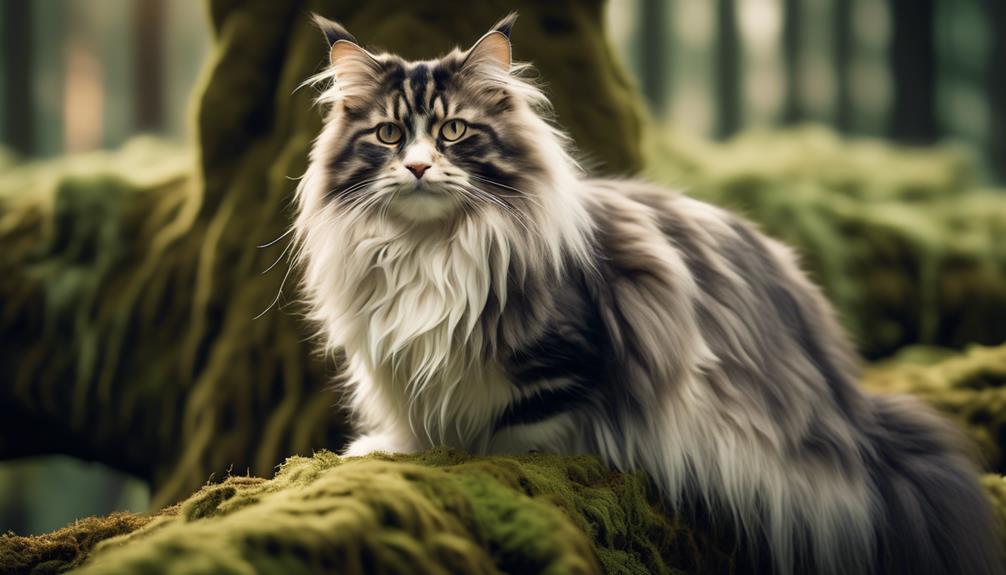
In a world filled with feline companions, the Norwegian Forest Cat stands tall, quite literally.
This breed is an enchanting sight with its majestic appearance and strikingly beautiful fur.
But what lies beneath this regal exterior? What secrets does this storied cat hold?
The Norwegian Forest Cat captivates the imagination from its ancient origins to its distinctive characteristics.
So, prepare to embark on a journey through time and explore the intriguing world of this captivating breed.
Key Takeaways
- Norwegian Forest Cats are friendly, intelligent, and independent.
- They have moderate exercise needs and enjoy climbing and playing.
- Regular grooming, including brushing their long coat, is essential.
- They are generally healthy but prone to certain genetic conditions, so regular vet check-ups are important.
Origin and Size
The Norwegian Forest Cat, originating from Norway, is a medium to large-sized breed known for its unique characteristics.
This breed has a long and fascinating history, with roots that can be traced back to ancient times.
The Norwegian Forest Cat is known for its strong and muscular build, with males weighing 13 to 22 pounds or more.
Females are somewhat smaller in size. This breed has a slow maturation process and isn’t fully grown until around five.
Despite their size, Norwegian Forest Cats have a gentle and affectionate nature, enjoying the company of their human family members.
They aren’t lap cats but appreciate a good scratch behind the ears or beneath the chin.
With their classic Scandinavian restraint, they communicate with a quiet voice.
See another cat breed profile.
Ocicat Cat Breed
Temperament and Care
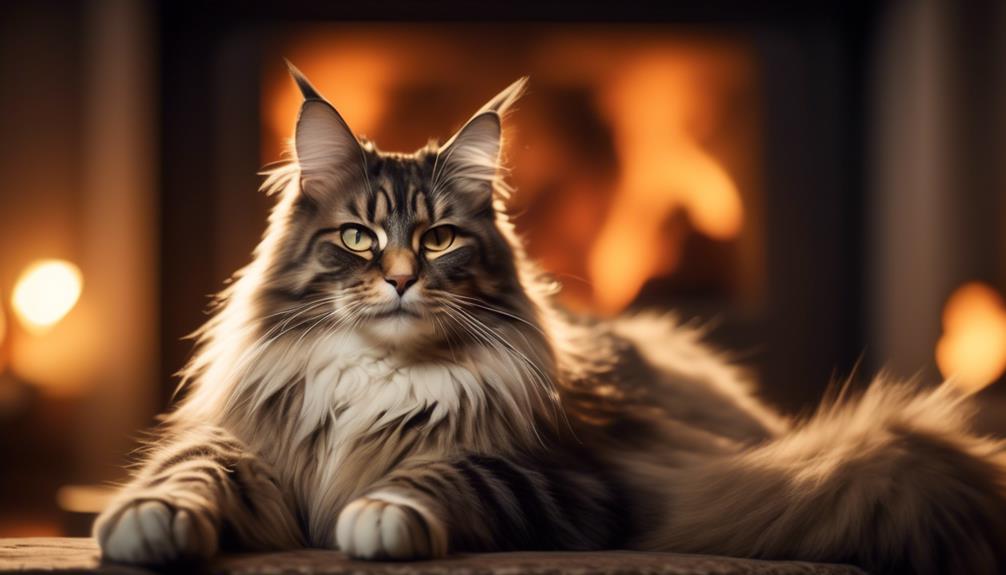
Norwegian Forest Cats are known for their friendly and independent nature, making them a joy to have as pets.
Here are some important points to consider about their temperament and care:
- Strong Hunting Instincts: Norwegian Forest Cats have a hunting instinct, so providing them with mental and physical stimulation through interactive toys and playtime is important.
- Moderate Exercise Needs: While they enjoy climbing and playing, Norwegian Forest Cats don’t require excessive exercise. Regular play sessions and access to vertical spaces, like cat trees, will keep them happy and healthy.
- Regular Grooming: Due to their dense fur, regular grooming is essential for Norwegian Forest Cats. Brush or comb their long coat once or twice a week to prevent matting and keep their fur in good condition.
- Clean Environment: Norwegian Forest Cats appreciate a clean environment, so it’s important to keep their litter box spotlessly clean and provide a tidy living space for them.
Exercise and Grooming Needs
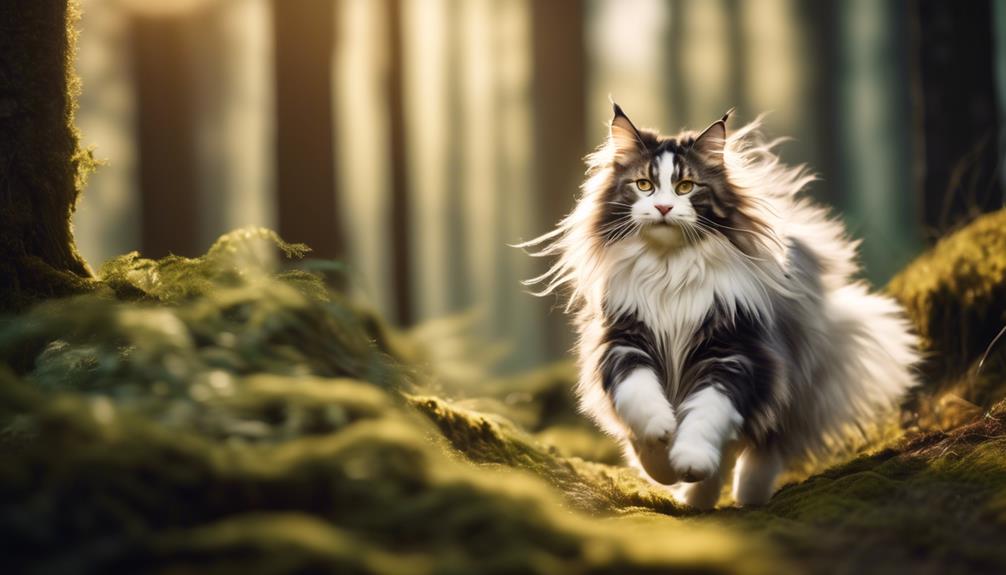
To keep a Norwegian Forest Cat healthy and happy, addressing their exercise and grooming needs is important.
These cats have moderate exercise requirements and enjoy activities like climbing and playing.
Engaging in these activities not only keeps them physically active but also helps to stimulate their intelligent and curious minds.
In terms of grooming, regular maintenance is essential due to their dense fur.
It’s recommended to brush or comb their long coat once or twice a week to prevent matting and tangles.
Bathing is rarely necessary as their waterproof coat naturally repels dirt and moisture.
Additionally, it’s important to regularly brush their teeth, wipe the corners of their eyes, and keep their litter box clean to ensure their overall health and well-being.
Health Considerations
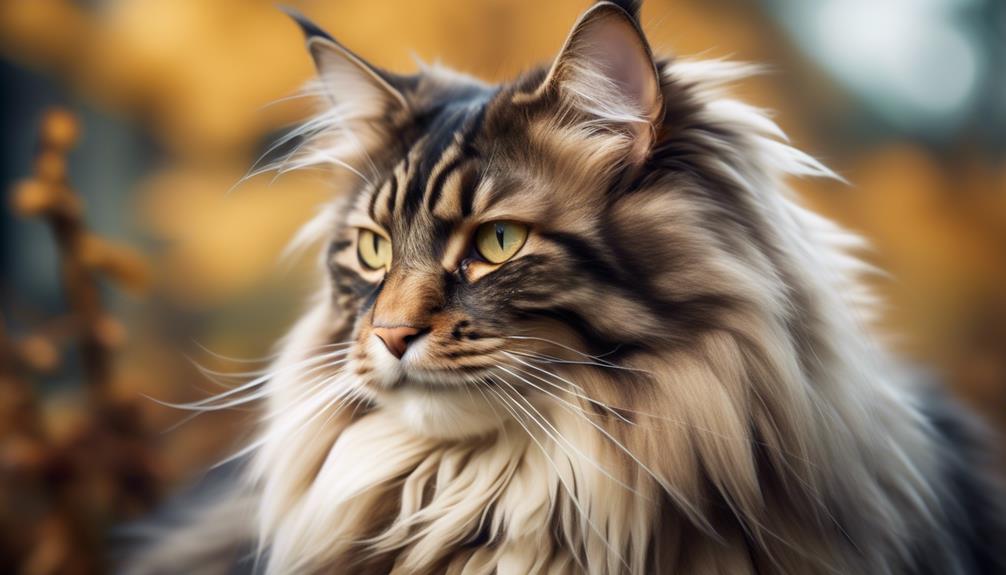
Addressing the health considerations of Norwegian Forest Cats is crucial for their overall well-being and longevity.
To ensure their health, there are several important factors to consider:
- Regular vet check-ups: Routine visits to the veterinarian are essential for monitoring the cat’s health, detecting any potential issues early on, and providing necessary vaccinations.
- Genetic conditions: Norwegian Forest Cats are prone to certain genetic conditions such as hip dysplasia, heart disease, Glycogen Storage Disease IV, Hypertrophic Cardiomyopathy, Polycystic Kidney Disease, and Retinal Dysplasia. Breeders need to conduct necessary screenings and prioritize the health of their cats.
- Healthy diet and exercise: Proper nutrition and regular exercise are vital for maintaining the cat’s overall health and preventing obesity.
- Adoption from reputable sources: When considering getting a Norwegian Forest Cat, it’s recommended to adopt from rescue organizations or shelters that prioritize the health of the cats and conduct necessary screenings.
Importance of Regular Vet Check-ups
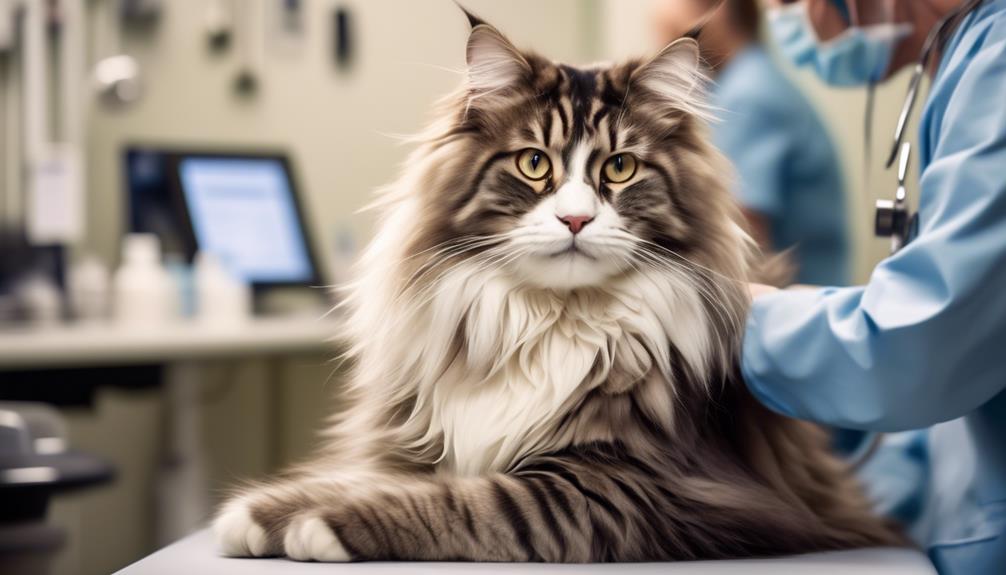
Regular vet check-ups are essential for maintaining the health and well-being of Norwegian Forest Cats.
These check-ups allow veterinarians to monitor the cat’s overall health, catch potential issues early on, and provide necessary preventive care.
Due to their genetic predisposition to certain conditions like hip dysplasia, heart disease, and Polycystic Kidney Disease, it’s crucial to have regular screenings and examinations to ensure early detection and appropriate treatment.
Additionally, regular vet check-ups allow for vaccinations and parasite prevention, vital for keeping the cat healthy and protected against common diseases.
Responsible Breeding and Adoption
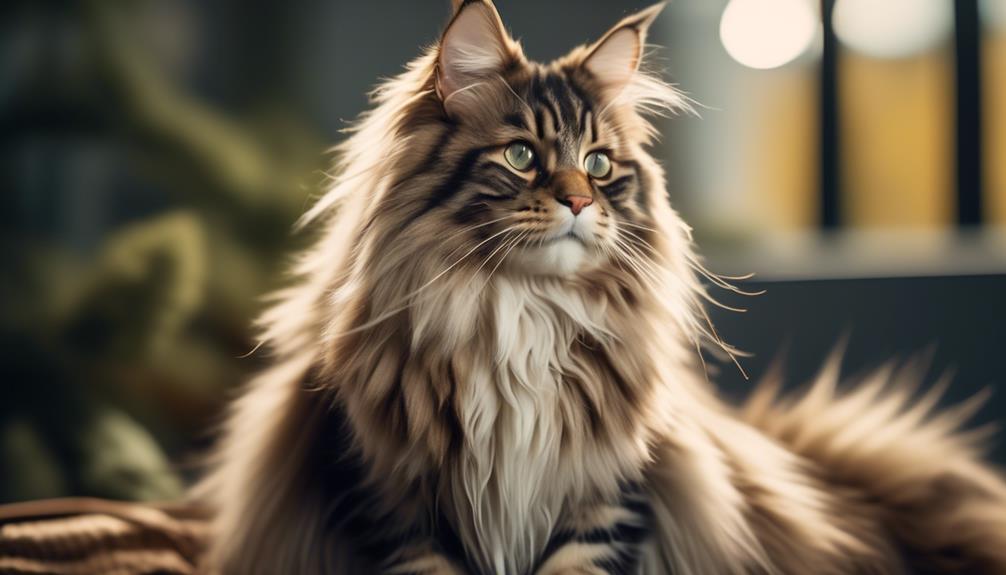
Regular vet check-ups are crucial for maintaining the health and well-being of Norwegian Forest Cats.
Responsible breeding and adoption play an integral role in ensuring the future welfare of this beloved breed.
To promote responsible breeding and adoption practices, here are four key points to consider:
- Health screenings: Reputable breeders prioritize their cats’ health and conduct necessary screenings for genetic conditions. This helps reduce the risk of passing on hereditary diseases to future generations.
- Responsible breeding practices: Ethical breeders carefully select mating pairs, considering health, temperament, and breed standards. They also provide a clean and nurturing environment for the cats, ensuring their well-being throughout breeding.
- Adoption from shelters and rescues: Many Norwegian Forest Cats need loving homes and can be found in shelters and rescue organizations. Adopting from these sources not only helps provide a second chance for these cats but also supports the efforts to reduce overpopulation and promote responsible pet ownership.
- Education and awareness: Promoting responsible breeding and adoption involves educating potential owners about the breed’s specific needs, temperament, and care requirements. This helps ensure that the cats are placed in suitable and loving homes, leading to happier and healthier lives for both the cats and their owners.
Shedding and Affection Levels
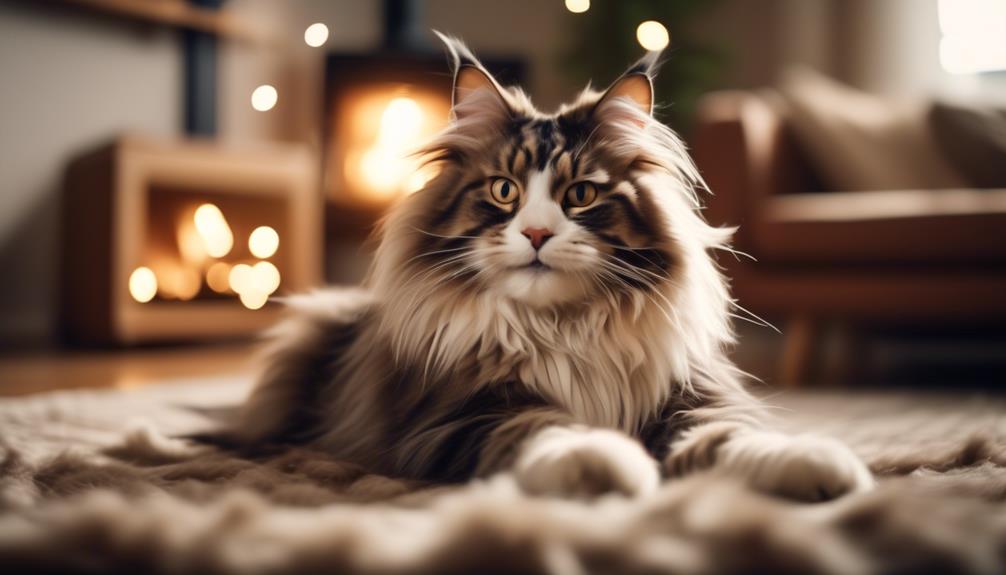
Shedding and affection levels vary among Norwegian Forest Cats, making each unique in their grooming needs and level of affection towards their human companions.
While some Norwegian Forest Cats have low shedding levels, others may shed more frequently.
Regular grooming is important to keep their dense fur in good condition.
As for affection levels, Norwegian Forest Cats are known to be generally affectionate with their family members.
However, the degree of playfulness and vocalization can vary among individuals.
They aren’t lap cats, but they enjoy receiving affection through a nice scritch between the ears or beneath the chin.
Norwegian Forest Cats subtly communicate their needs and emotions with their quiet voices and classic Scandinavian restraint.
Playfulness and Vocalization Tendencies
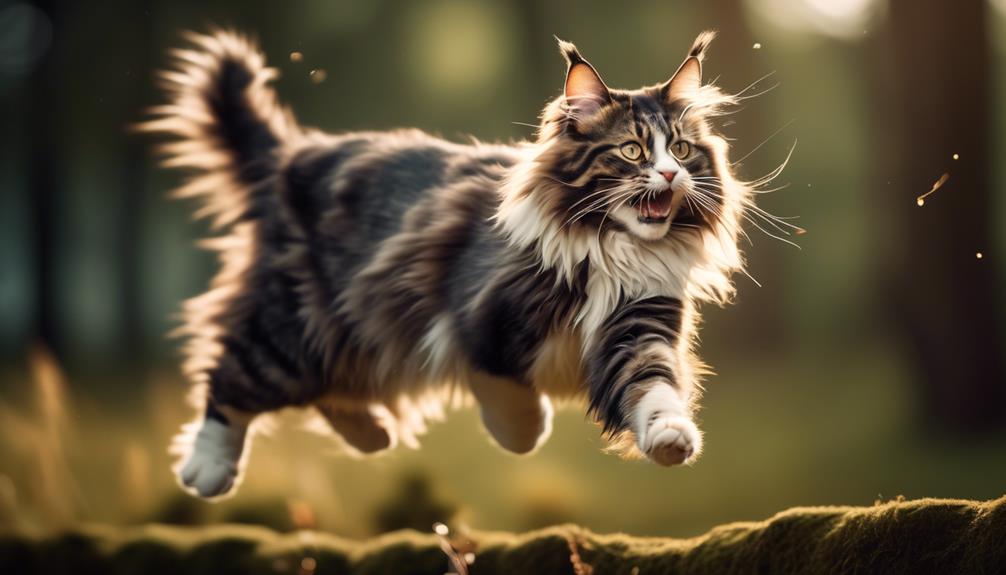
Norwegian Forest Cats exhibit varying playfulness and vocalization tendencies, adding to their unique personalities.
Here are four key points to understand about their playfulness and vocalization:
- Playfulness: Some Norwegian Forest Cats are highly active and love to engage in playtime, while others may be more laid-back and prefer quieter activities. Their strong hunting instincts make them enjoy interactive toys and climbing structures.
- Vocalization: While some Norwegian Forest Cats are known to be quite talkative and enjoy vocalizing with their human companions, others may be more reserved and communicate with a softer voice. Their vocalization tendencies can vary greatly from cat to cat.
- Individual Differences: It’s important to remember that each Norwegian Forest Cat has its unique personality. Some may be playful and vocal, while others may be more independent and quiet. Understanding and respecting these differences is key to building a strong bond with your cat.
- Environmental Factors: The playfulness and vocalization tendencies of Norwegian Forest Cats can also be influenced by their environment. Providing them with stimulating toys, play areas, and social interaction can help bring out their playful and vocal side.
Size Differences Between Males and Females
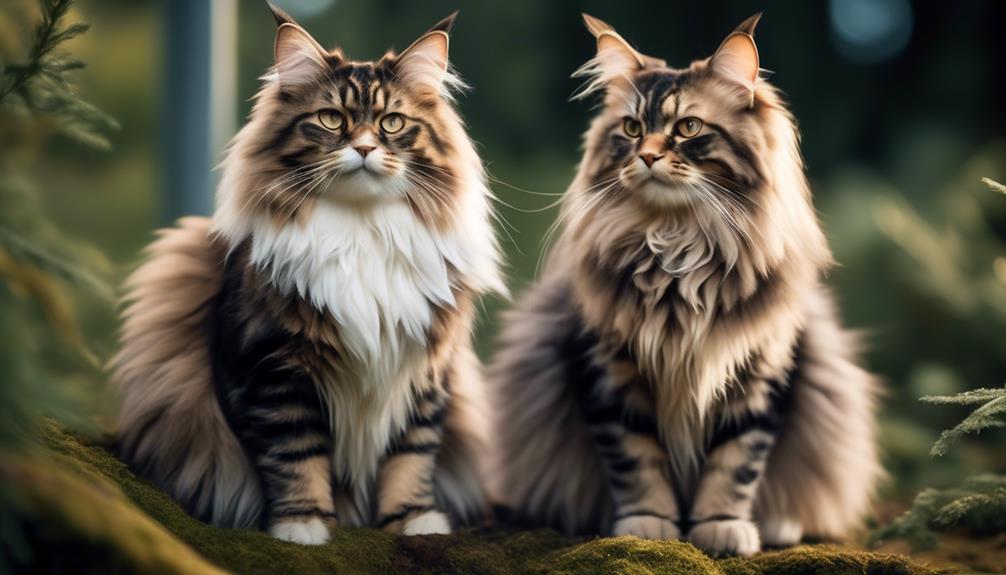
After understanding the playfulness and vocalization tendencies of Norwegian Forest Cats, it’s important to note that there are size differences between males and females of this breed.
Males tend to be larger, weighing between 13 to 22 pounds or more, while females are smaller.
It’s worth mentioning that the Norwegian Forest Cat matures slowly and isn’t fully grown until around five years of age.
Despite their size differences, both genders of this breed are known for their affectionate nature and satisfaction with being in the same room as their humans.
They may not be lap cats, but they enjoy receiving attention through gentle strokes behind the ears or under the chin.
Additionally, Norwegian Forest Cats communicate with a quiet voice, showcasing their classic Scandinavian restraint.
Slow Maturation and Independent Nature
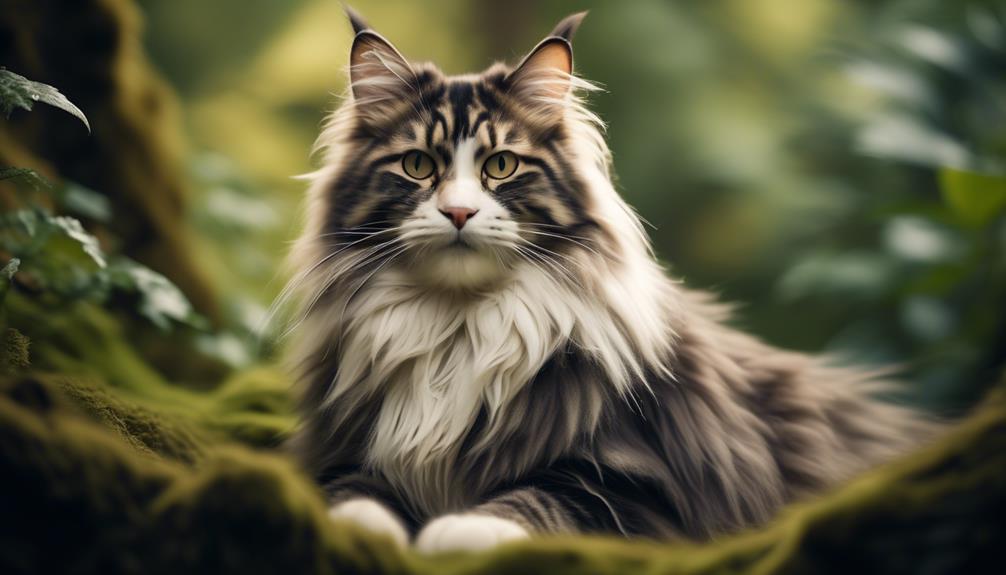
The Norwegian Forest Cat exhibits a slow maturation process and is independent.
This breed takes longer than other cats to reach full physical and behavioral maturity.
Here are four key characteristics that highlight their slow maturation and independent nature:
- Development: Norwegian Forest Cats aren’t fully grown until around five years of age. They have a slower growth rate, with their size and appearance continuing to develop over several years.
- Self-sufficiency: These cats have an independent streak and are known to entertain themselves when left alone. They’re content to be in the same room as their owners but may be reserved with visitors.
- Moderate social needs: While not lap cats, Norwegian Forest Cats enjoy affection such as a nice scritch between the ears or beneath the chin. They communicate with a quiet voice, exhibiting classic Scandinavian restraint.
- Minimal grooming needs: Norwegian Forest Cats require only moderate grooming despite their long, dense fur. Their waterproof coat rarely needs bathing, and regular brushing helps keep their fur in good condition.
Communication Style and Behavior With Visitors
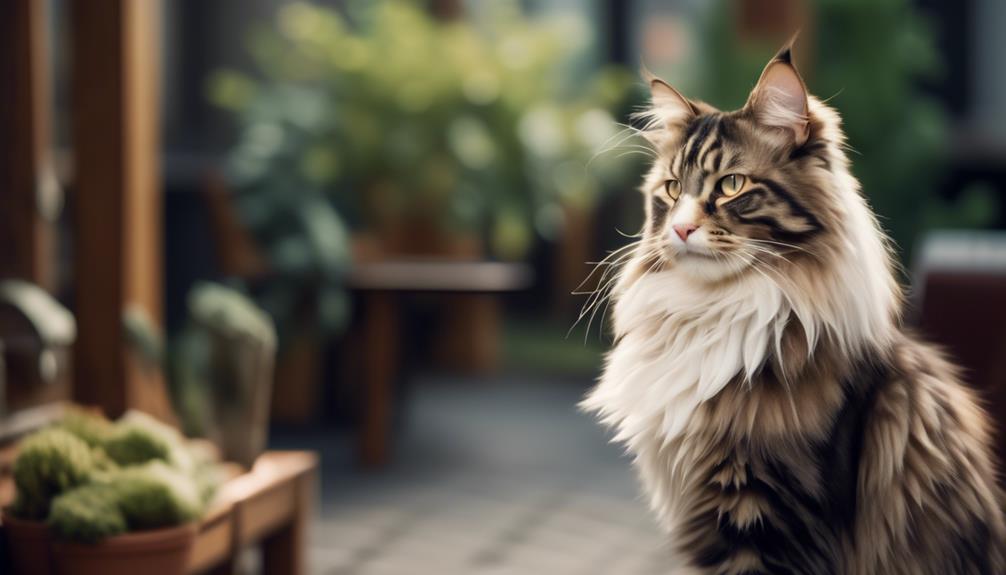
When interacting with visitors, the Norwegian Forest Cat maintains a reserved demeanor while communicating with a quiet voice.
This breed is not known for being overly social or seeking attention from strangers.
Instead, they prefer to observe from a distance and assess the situation before engaging.
Norwegian Forest Cats are not typically lap cats, but they enjoy receiving affection through gentle ear or chin scratches.
To give you a better understanding of the Norwegian Forest Cat’s communication style and behavior with visitors, here is a table outlining their typical characteristics:
| Communication Style | Behavior With Visitors |
|---|---|
| Reserved demeanor | Observe from a distance |
| Quiet voice | Avoids direct interaction |
| Not overly social | Prefers to assess the situation first |
| Enjoys gentle affection | Appreciates ear or chin scratches |
This reserved and cautious approach to interacting with visitors is an instinct for the Norwegian Forest Cat.
Historical Significance and Folklore

The Norwegian Forest Cat holds a significant place in history and folklore, captivating the imagination with its majestic presence and mysterious origins.
Here are four key points about its historical significance and folklore:
- Figures in fairy tales and legends: The Norwegian Forest Cat is often associated with the goddess Freya in Norse mythology. It’s believed to have played a role in ancient fairy tales and legends, adding to its allure and mystique.
- Possible origins: While the exact origin of the Norwegian Forest Cat remains a mystery, some theories suggest that it could be descendants of longhaired cats from Turkey or related to the Siberian cat from Russia. Others speculate that they may have been Viking booty or the result of natural selection.
- Significance in Norse mythology: The Norwegian Forest Cat holds a special place in Norse mythology, where it’s believed to have pulled the goddess Freya’s chariot. This connection further enhances its mythical and historical significance.
- Folklore and cultural significance: The Norwegian Forest Cat’s presence in folklore reflects its importance in Norwegian culture. It’s often depicted as a guardian and a symbol of good luck, with stories passed down through generations, further solidifying its historical place.
The Norwegian Forest Cat’s Mysterious Origins
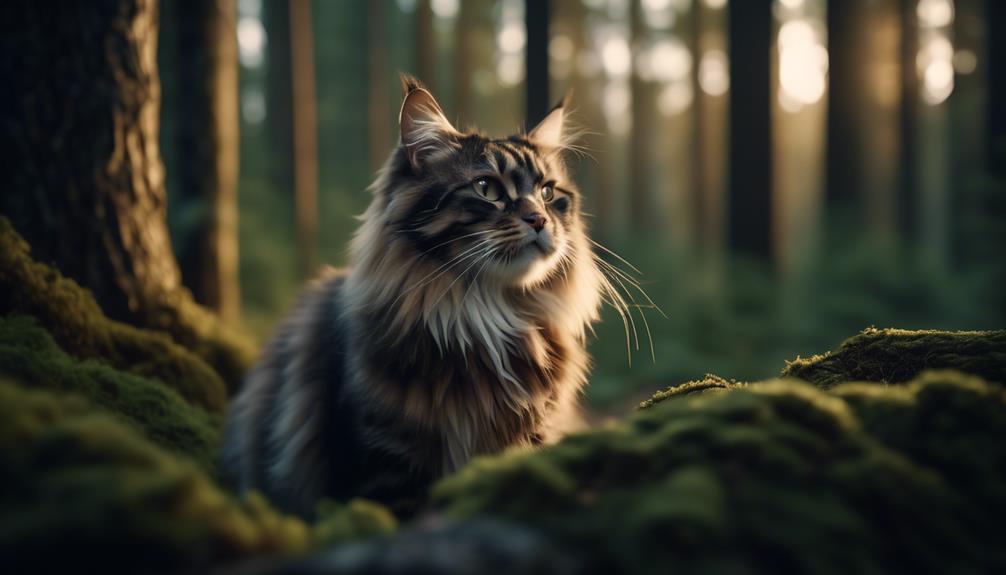
With its captivating history deeply rooted in Norse mythology and folklore, the Norwegian Forest Cat’s mysterious origins have long fascinated cat enthusiasts and historians alike.
While the exact origin of the breed remains uncertain, several theories have been proposed.
One possibility is that the Norwegian Forest Cat is descended from longhaired cats brought by Vikings during their travels, becoming naturalized in Norway over time.
Another theory suggests that the breed is related to the Siberian cat from Russia or descended from longhaired cats from Turkey.
Regardless of their true origins, Norwegian Forest Cats have a significant place in Norse mythology and folklore, often being associated with the goddess Freya and featuring in fairy tales and legends.
Their enigmatic beginnings only add to their allure and charm.
| Theories of Origin | ||
|---|---|---|
| Descendants of longhaired cats brought by Vikings | Related to the Siberian cat from Russia | Descended from longhaired cats from Turkey |
The Norwegian Forest Cat’s mysterious origins continue to spark curiosity and speculation, but the breed’s undeniable beauty and unique characteristics make it a beloved and cherished companion for many.
Frequently Asked Questions
What Is the Average Cost of a Norwegian Forest Cat?
The average cost of a Norwegian Forest Cat can vary depending on location, breeder reputation, and the cat’s pedigree.
Researching and contacting breeders or rescue organizations for specific pricing information is recommended.
Are Norwegian Forest Cats Good With Children and Other Pets?
Norwegian Forest Cats are generally good with children and other pets. They are affectionate and friendly, making them great companions for families.
Their independent nature allows them to adapt well to different environments and socialize with others.
Can Norwegian Forest Cats Be Trained to Walk on a Leash?
Yes, Norwegian Forest Cats can be trained to walk on a leash. They are intelligent and can learn new skills.
However, individual cats may have different interest levels and cooperation in leash training.
Do Norwegian Forest Cats Have Any Dietary Restrictions?
No, Norwegian Forest Cats do not have any specific dietary restrictions.
However, providing them with a balanced and nutritious diet is important to maintain their overall health and well-being.
How Often Should Norwegian Forest Cats Be Taken to the Groomer for Professional Grooming?
Norwegian Forest Cats generally do not require professional grooming unless their owners prefer it.
Regular at-home grooming, including brushing their long coat once or twice a week, is usually sufficient to keep them looking their best.
Conclusion
In conclusion, the Norwegian Forest Cat is a fascinating and beloved breed known for its friendly nature, intelligence, and strong hunting instincts.
With their medium to large size and dense fur, these cats require regular grooming and proper dental and eye care.
While generally healthy, they may be prone to genetic conditions. Slow to mature, they aren’t fully grown until five years of age.
With their rich history and association with Norse mythology, Norwegian Forest Cats continue to captivate and enchant cat lovers worldwide.




